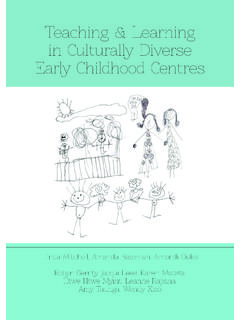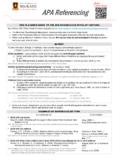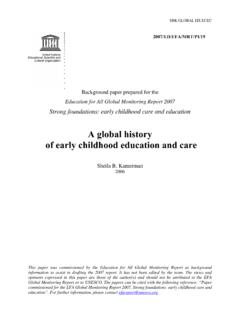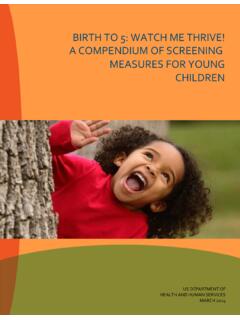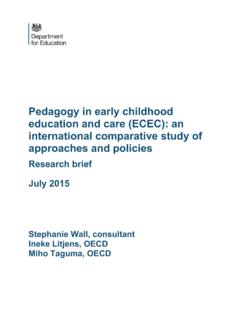Transcription of Teaching & Learning in Culturally Diverse Early Childhood ...
1 Teaching & Learning in Culturally Diverse Early Childhood Centres Linda Mitchell, Amanda Bateman, Amondi Ouko Robyn Gerrity, Jacqui Lees, Karen Matata, Htwe Htwe Myint, Leanne Rapana, Amy Taunga, Wendy Xiao Teaching and Learning in Culturally Diverse Early Childhood Settings Linda Mitchell, Amanda Bateman, Amondi Ouko Robyn Gerrity, Jacqui Lees, Karen Matata, Htwe Htwe Myint, Leanne Rapana, Amy Taunga, Wendy Xiao January 2015. Mitchell, L., Bateman, A., Ouko, A., Gerrity, R., Lees, J., Matata, K.. Xiao, W., (2015). Teaching and Learning in Culturally Diverse Early Childhood settings. Hamilton, New Zealand: Wilf Malcolm Institute of Educational Research. First published 2015. By Wilf Malcolm Institute of Educational Research (WMIER), Faculty of education , The University of Waikato, Private Bag 3105, Hamilton, 3240, New Zealand Authors Linda Mitchell, Amanda Bateman, Amondi Ouko, (The University of Waikato), Jacqui Lees, Wendy Xiao, Karen Matata, Leanne Rapana, Amy Taunga, Robyn Gerrity, Htwe Htwe Myint Jacqui Lees & Wendy Xiao (Pakuranga Baptist Kindergarten).
2 Karen Matata, Leane Rapana & Amy Taunga (Mangere East Family Service Centre). Robyn Gerrity & Htwe Htwe Myint (Carol White Family Centre). Cover design: Louise Hutt Printed by: Waikato Print, Hamilton, New Zealand Wilf Malcolm Institute of Educational Research All rights reserved. No part of this publication may be reprinted, reproduced or utilised in any form by any electronic, mechanical, or other means, now known or hereafter invented, including photocopying or recording, or in any information retrieval system without permission in writing of the publishers. ISBN: 978-0-9922497-8-6 (Print). ISBN: 978-0-9922497-9-3 (online). ACKNOWLEDGEMENTS. This research was undertaken with support from a University of Waikato Faculty of education Research grant.
3 We wish to thank and acknowledge the parents and children who allowed us to video their children and who took part in interviews with us. Families from the Carol White Centre invited us into their homes for these interviews, offering us wonderful food and hospitality and an opportunity to meet with their wh nau. Thanks to Margaret Drummond for her help in putting the report together. Teaching and Learning in Culturally Diverse Early Childhood Settings Page 1. Teaching and Learning in Culturally Diverse Early Childhood Settings Page 2. TABLE OF CONTENTS. Acknowledgements 1 Table of contents 3 Executive summary 5 Research questions .. 5 Theoretical frame .. 5 Methods .. 5 Findings .. 6 1. Introduction 7 Background .. 7 A way forward.
4 8 Layout of the report .. 9 2. Methodology 11 Research questions .. 11 Theoretical frame .. 11 Participants .. 11 Methods .. 12 Data analysis .. 13 3. Pakuranga Baptist Kindergarten 15 Belonging .. 16 Engagement with family cultural values and educational views .. 18 Languages .. 21 Stimulating cross-cultural Learning and contribution .. 28 Staffing and resources .. 29 Discussion .. 29 4. Mangere East Family Service Centre 31 Wellbeing and belonging .. 32 Empowering for families .. 33 Language, culture and 34 Discussion .. 40 5. Carol White Family Centre 41 A social justice philosophy .. 43 Family values and aspirations .. 44 A family centred community creating a fair world .. 47 Communication, language and identity .. 50 Discussion.
5 52 6. Conclusion 53 Relationship-based practice .. 53 A willingness to learn as well as teach .. 53 Language, communication and identity .. 54 Weaving Te Wh riki .. 54 7. References 57 Teaching and Learning in Culturally Diverse Early Childhood Settings Page 3. Teaching and Learning in Culturally Diverse Early Childhood Settings Page 4. EXECUTIVE SUMMARY. Recent research has highlighted challenges for refugees and immigrants in accessing Early Childhood education (ECE) services that are responsive to their cultural and linguistic identities and to the contexts of their lives. However, there are few studies of how Early Childhood pedagogy can address such challenges. This qualitative study aimed to generate an exploration and analysis of Culturally responsive Teaching and Learning in three Diverse education and care centres.
6 It investigated how teachers in these Diverse settings practically implemented their values by drawing on the funds of knowledge and cultural capital of the families they worked with, weaving these values into the fabric of the national curriculum, Te Wh riki. In doing so, the research aimed to identify Culturally responsive Teaching practice. Research questions The two research questions were: 1. What does Culturally Diverse Teaching and Learning look like in Early Childhood settings? 2. How are the values and practices of Diverse families accessed and integrated into the curriculum? Theoretical frame Teachers and researchers worked within a social constructionist theoretical frame which holds that concepts are socially constructed within an historical and cultural context.
7 The research involved collaborations between the university researchers and two or three teachers in each of three Culturally Diverse Early Childhood education (ECE) centres. At the start of the project and towards the end of the project, the three Teaching teams and researchers came together for a day's workshop. In these ways the pedagogical knowledge of the teachers and the research knowledge of the researchers were able to be pooled. Methods The three education and care centres were: Mangere East Family Service Centre, an integrated ECE. centre with health and social services and a predominantly Pasifika and M ori community; Pakuranga Baptist Kindergarten, a centre with a predominantly Asian community; and the Carol White Centre, a centre for children from refugee families with adult Learning opportunities alongside.
8 Data was collected through: Focus group discussions with the six participating teachers held at an initial workshop to investigate and discuss teachers' experiences and ideas about Culturally responsive pedagogy. Video recordings of three case study children taken in each centre during their free play. Video recordings of the participating teachers taken in each centre to capture the arrival of families and children and included the children's transition from family members to the teachers. Semi-structured interviews held with the parents of the children in their family home or at the centre. Parents were asked to view selected episodes of the videotape and their narrative stories regarding the episode were recorded. The video recordings were used as a catalyst for discussion about Learning that is valued, their child's strengths, interests and strategies as Teaching and Learning in Culturally Diverse Early Childhood Settings Page 5.
9 Learners, the funds of knowledge families hold, experiences and aspirations for their child, and continuities between home and centre. Semi-structured interviews were held with the participating teachers in each centre, who were asked to view the videotapes of themselves Teaching and of the children, and pick out episodes that they thought were significant, especially related to belonging, communication, language and culture. They were asked to explain reasons for their choice. Findings Each centre was absolutely distinctive and main themes, examples and documentation from each are discussed in three separate chapters, Chapters 3, 4 and 5. However, in looking across the three centres, some generalisations could be drawn. The role of the teachers was relationship-based, an idea that is at the heart of the Te Wh riki curriculum (Peters, 2009, p.)
10 23). Teachers had developed strategies for intercultural exchange of ideas within their own Teaching team and with families. They took responsibility for finding out about family values and catering for these within their practice. The teachers provided an environment that was co-constructed with family members and aligned with the Relationships' principle of Te Wh riki. The context of the ECE centres was co-produced each member contributing to the setting to create the setting. The creation of a new world' within each centre was managed by the shared values of the teachers and families, where the teachers valued and spent time in observing what each family needed and where, and through taking time to listen to parents and children.
